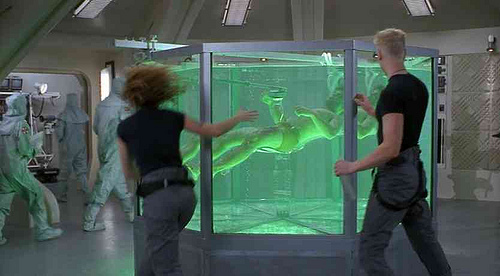Science Fiction
Dictionary
A B C D E F G H I J K L M N O P Q R S T U V W X Y Z
Robot Performs 3D Bioprinting Inside The Body

This remarkable soft robotic arm can be used to 3D print biological material directly onto existing organs in the human body.
The new research from UNSW Medical Robotics Lab, led by Dr. Thanh Nho Do and his Ph.D. student Mai Thanh Thai, in collaboration with other researchers from UNSW including Scientia Professor Nigel Lovell, Dr. Hoang-Phuong Phan, and Associate Professor Jelena Rnjak-Kovacina, is detailed in a paper published in Advanced Science.Their work has resulted in a tiny flexible 3D bioprinter that has the ability to be inserted into the body just like an endoscope and directly deliver multilayered biomaterials onto the surface of internal organs and tissues.
The proof-of-concept device, known as F3DB, features a highly maneuverable swivel head that "prints" the bioink, attached to the end of a long and flexible snake-like robotic arm, all of which can be controlled externally.
(Via MedicalXpress.)
This bioprinter appears to accomplish in reality what this fictional device from the movie Starship Troopers is doing.

(Starship Troopers medical tank)
Also, it would make possible what sf writer Philip K. Dick envisioned in his 1969 masterpiece Ubik. Dick introduced the idea of implanting secondary artificial organic organs - perhaps smaller versions of the originals - as backup.
Probably Runciter's body contained a dozen artiforgs, artificial organs grafted into place in his physiological apparatus as the genuine, original ones, failed.
(Read more about Dick's artiforgs)
Scroll down for more stories in the same category. (Story submitted 2/13/2023)
Follow this kind of news @Technovelgy.| Email | RSS | Blog It | Stumble | del.icio.us | Digg | Reddit |
Would
you like to contribute a story tip?
It's easy:
Get the URL of the story, and the related sf author, and add
it here.
Comment/Join discussion ( 0 )
Related News Stories - (" Medical ")
Brain Implant Is Able To Capture Your Inner Dialogue
'So you see, you can hide nothing from me.'
'Pregnancy Humanoids' From China Replace Moms
'A great many of these synthetic babies were made...' - David H. Keller, 1928.
Bacteria Turns Plastic Into Pain Relief? That Gives Me An Idea.
'I guess there's nobody round this table who doesn't have a Crosswell [tapeworm] working for him in the small intestine.'
Heart Patches Grown In The Lab Repair Hearts
I'm hoping that this procedure becomes a normal part of medical practice!
Technovelgy (that's tech-novel-gee!) is devoted to the creative science inventions and ideas of sf authors. Look for the Invention Category that interests you, the Glossary, the Invention Timeline, or see what's New.
Science Fiction
Timeline
1600-1899
1900-1939
1940's 1950's
1960's 1970's
1980's 1990's
2000's 2010's
Current News
Jetson ONE Air Races Begin, Can Air Polo Be Far Behind?
'If you're one of those rarities who haven't attended a rocket-polo "carnage", let me tell you it's a colorful affair.'
Will Space Stations Have Large Interior Spaces Again?
'They filed clumsily into the battleroom, like children in a swimming pool for the first time, clinging to the handholds along the side.'
Mornine Sales Robot
'Robot-salesmen were everywhere, gesturing...'
Bipedal Robot Floats Gently While Walking
'a walking balloon proceeded with long strides of its aluminum legs...'
Musk Idea Of Cars Talking To Each Other Predicted 70 Years Ago
'My cars talk to one another.'
Elegant Bivouac Shelter Produces Water And Electricity
'There was nowhere on the planet where science and technology could not provide one with a comfortable home...'
X-Control Janus-1 A Suitcase Aircraft
'You will notice that it... fits the suitcase nicely.'
'AI Assistants' Are Actually Less Reliable For News
'Most men updated their PIP on New Year's Day...'
YES!! Remote Teleoperated Robots predicted by Technovelgy!
'...a misshapen, many-tentacled thing about twice the size of a man.'
Will Robots Ever Fold Landry?
Where have you gone, Mrs. Robinson?
Will AIs Give Better Results If You're Rude To Them?
'I said, "Listen up, motherf*cker.'
Cybertruck Robotic Arm F10 Drone Launch!
Drone away!
Black Fungus Blocks Radiation
'You were surrounded by Astrophage most of the time'
Liuzhi Process Now In Use In China
'He was in a high-ceilinged windowless cell with walls of glittering white porcelain.'
Reflect Orbital Offers 'Sunlight on Demand' And Light Pollution
'I don't have to tell you about the seven two-mile-diameter orbital mirrors...'
Will Robots Become Family Caregivers?
'The robant and the tiny old woman entered the control room slowly...'
